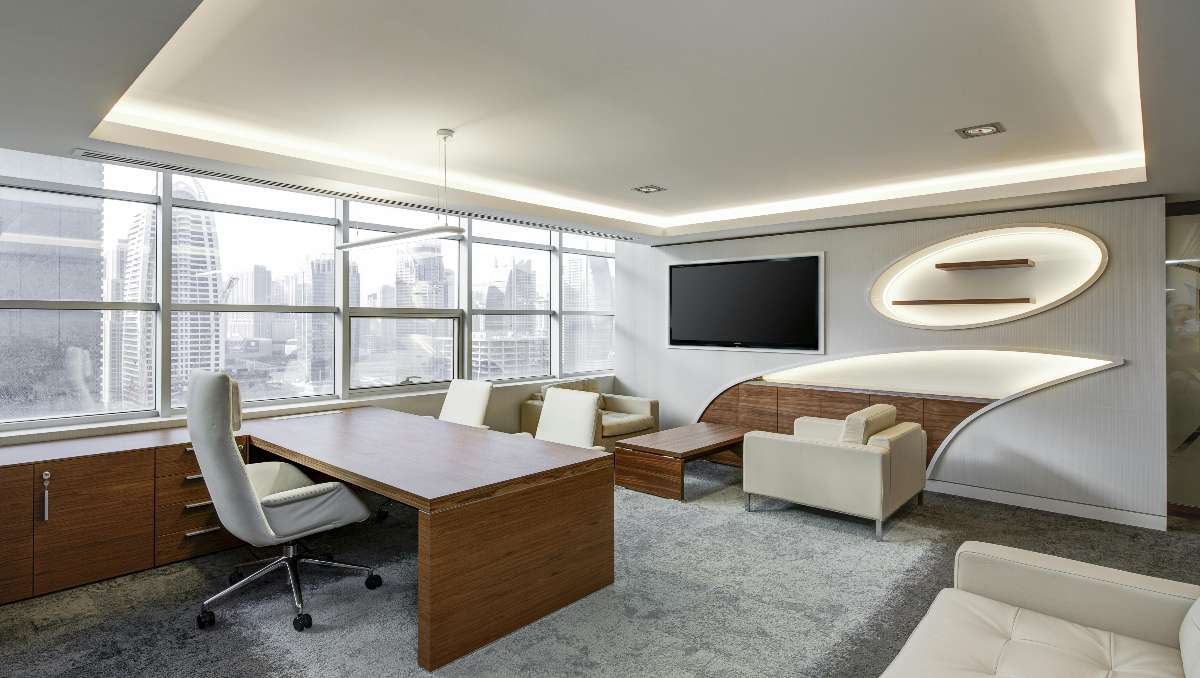
When it comes to building your own desk, choosing the right wood can be a game-changer. Not only does it impact the overall look of your workspace, but it also affects the desk’s durability and functionality. But with so many wood types out there, it’s tough to know where to start in choosing the best wood for building a desk. Should you go for that timeless rustic feel, or opt for a clean, modern, and sleek design?
Key Takeaways:
- The wood you choose determines whether your desk looks rustic or sleek.
- Rustic styles use woods like reclaimed wood and oak, while sleek designs work well with maple, cherry, and birch.
- You can combine rustic and sleek elements, like using reclaimed wood with metal accents, for a unique and stylish desk that mixes both looks.
In this article, we’re diving into the best woods for creating a desk based on two of the most popular design styles: rustic and sleek.
Understanding Rustic and Sleek Desk Styles
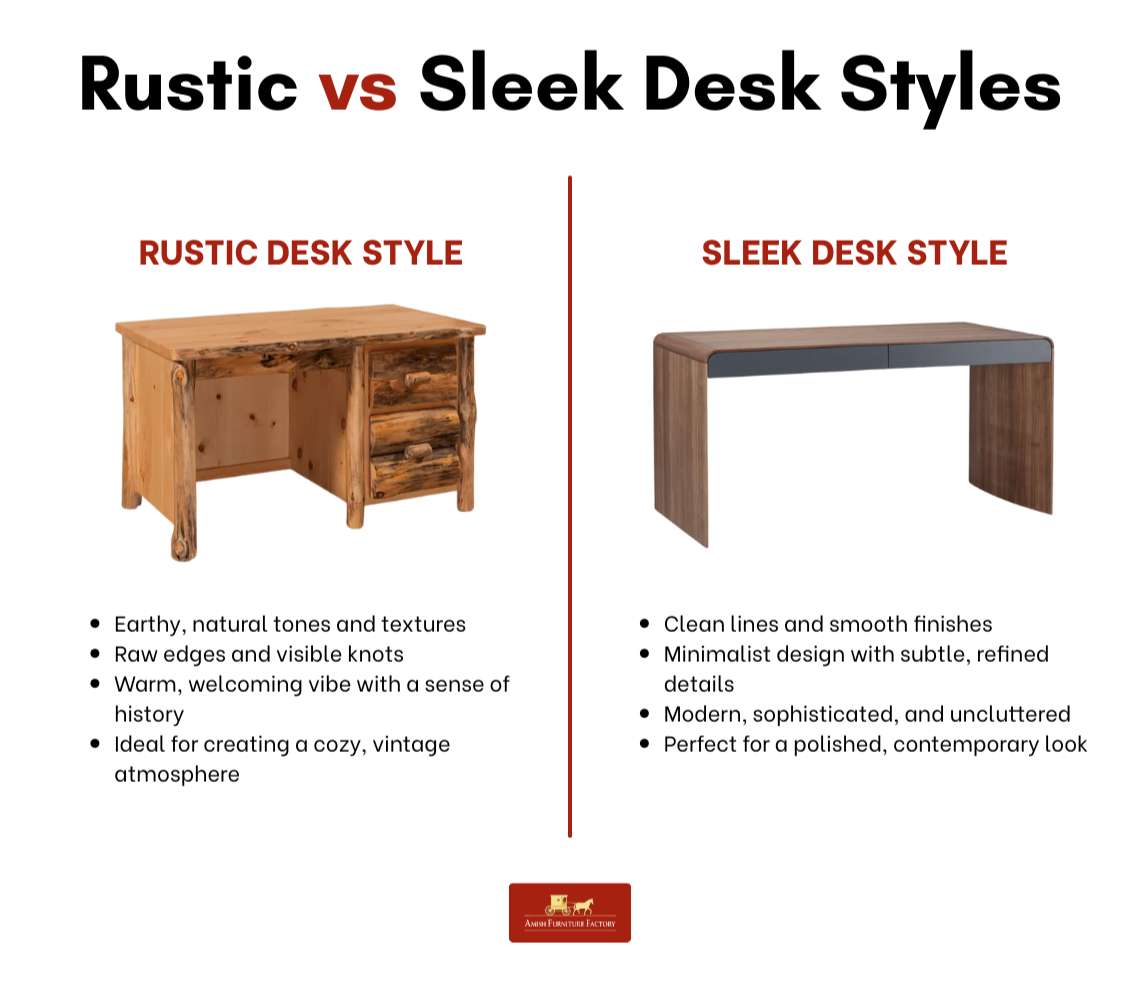
Let’s first break down what makes a desk rustic or sleek. A rustic desk usually brings in earthy, natural tones and textures that create a warm, welcoming vibe. Think of raw edges, visible knots, and a sense of history – the kind of desk that looks like it’s been around for generations. On the flip side, sleek desks are all about clean lines, smooth finishes, and minimalist designs. These desks exude modernity, sophistication, and an uncluttered aesthetic, often with subtle, understated details that make a bold statement without overwhelming the space.
Now that you have a sense of what each style represents, it’s time to talk about how the type of wood you choose can really bring these styles to life. Whether you’re drawn to the rustic charm of a countryside cabin or the polished sophistication of a contemporary office, your wood selection will set the tone.
Best Woods for Rustic Desks
If you’re leaning toward a rustic style, the wood you choose should reflect that natural, unpolished vibe.
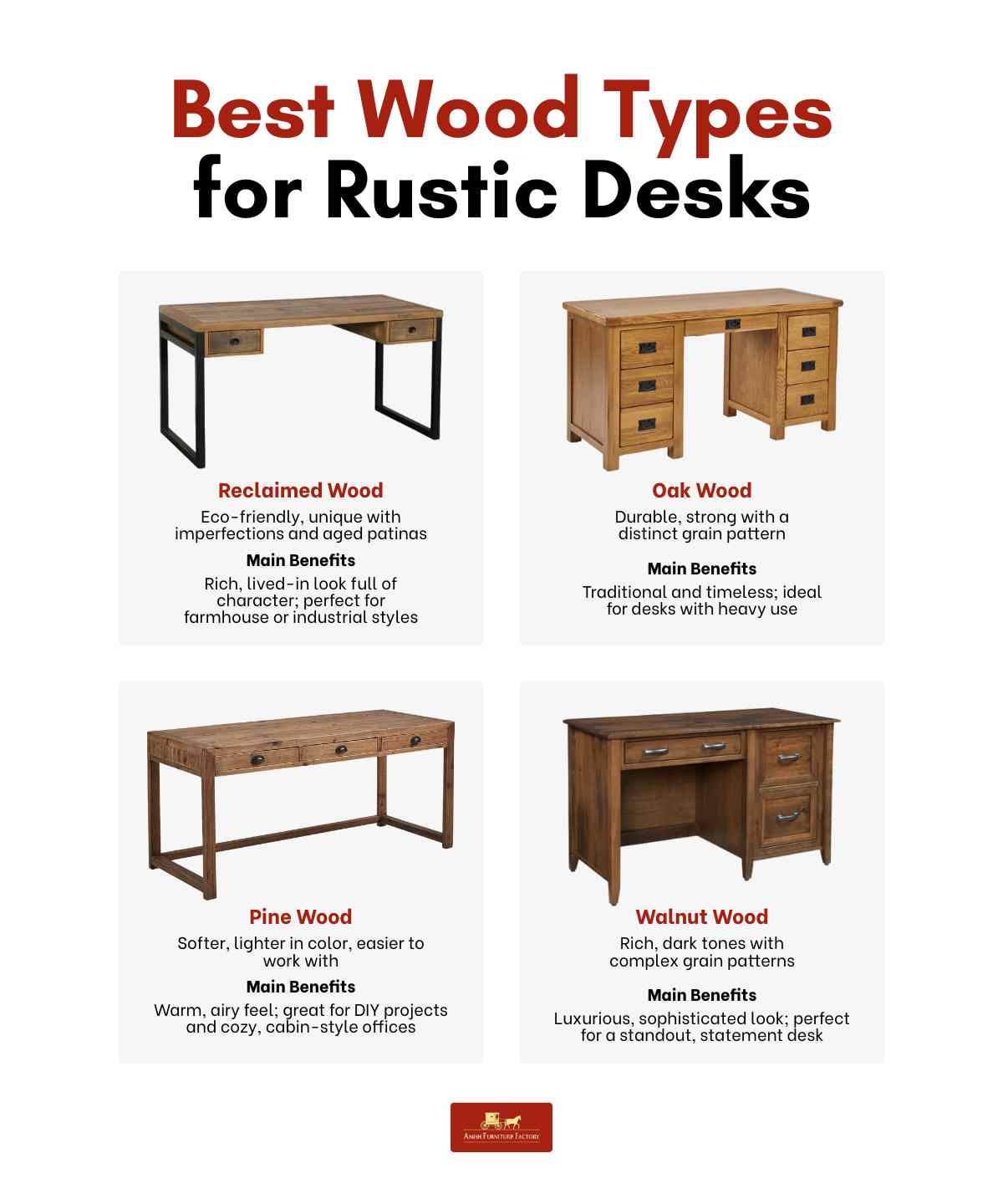
Reclaimed Wood
Reclaimed wood is a standout option here. Not only is it eco-friendly, but it also gives your desk a rich, lived-in look that’s full of history. Each piece of reclaimed wood is unique, with imperfections and aged patinas that tell a story. Whether you’re aiming for a farmhouse aesthetic or something with more of an industrial edge, reclaimed wood will give your desk a character that newer materials can’t quite match.
Oak Wood
Another great option for rustic desks is oak. Known for its durability and distinct grain, oak can bring a traditional touch to your workspace. Its strong, dense structure makes it ideal for a desk that’s going to see a lot of use.
Pine Wood
If you want something with a bit more warmth, pine is a great choice. It’s softer than oak, which makes it easier to work with for DIY projects. Pine also has a lighter color that works well in creating a bright, airy feel, perfect for cabin-inspired or cozy home-office settings.
Walnut Wood
If you’re after something a little more luxurious but still with that rustic touch, walnut is a beautiful choice. It has a rich, dark tone and complex grain patterns that make it a standout material for desks that are meant to make a statement.
Best Woods for Sleek Desks
When you’re designing a sleek, modern desk, you’ll want wood that contributes to a clean, minimal aesthetic.
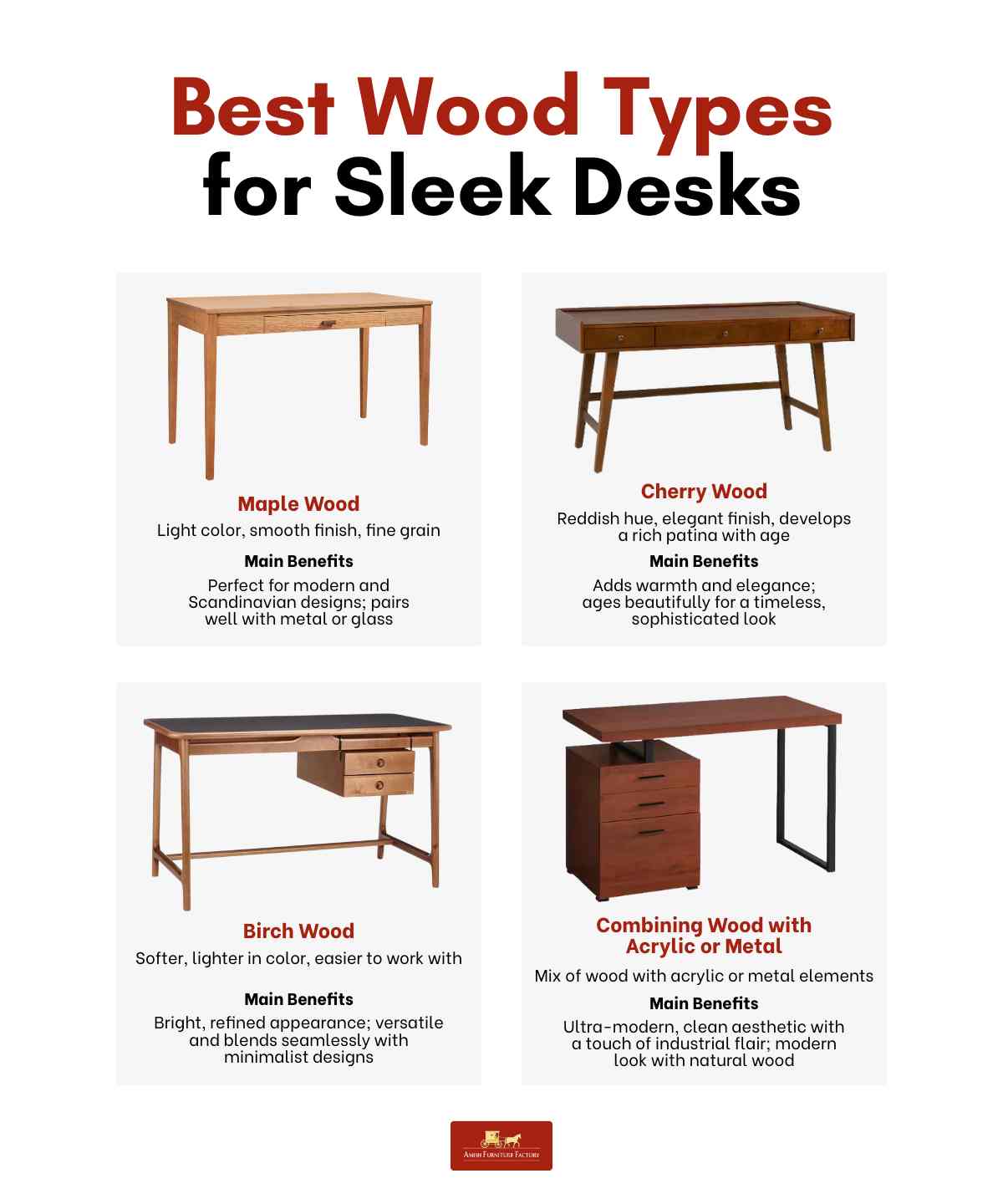
Maple
Maple is a top contender in this category. It has a light, smooth finish that works perfectly for contemporary or Scandinavian-inspired designs. Its fine grain and subtle color make it easy to pair with other materials, like metal or glass, for a truly modern look.
Cherry Wood
Cherry wood is another great option for a sleek desk, but with a bit more warmth. The reddish hue of cherry wood adds a touch of elegance to any office space, and as it ages, it becomes even more beautiful, developing a rich patina that enhances its sleek appeal.
Birch Wood
If you’re after something even lighter and brighter, birch wood is a fantastic choice. It’s known for its pale, almost white color and fine grain, which give it a refined yet approachable look. Birch is often used in modern furniture because of its versatility and ability to blend seamlessly with minimalist designs.
Combining Wood with Acrylic or Metal for a Sleek Twist
For a truly modern twist, some desks even combine wood with materials like acrylic or metal. The combination of a sleek wood base with clear acrylic or polished steel legs adds an ultra-modern feel while still keeping that natural wood element.
Factors to Consider When Choosing the Best Wood for Building a Desk
When choosing wood for your desk, durability is key, as it will endure daily wear and tear. The grain and texture of the wood also play a big role in the look and feel of your desk—rustic designs often feature a pronounced grain, while sleek styles benefit from a smoother finish. Maintenance is another consideration, as some woods require more care than others. Sustainability is important too, so opting for responsibly sourced or reclaimed wood can add both environmental and aesthetic value to your desk.
It’s also worth noting that you don’t have to choose between rustic and sleek. Many designers are blending these styles by combining rustic reclaimed wood with sleek metal legs, creating a striking and functional piece. You can also choose a neutral-toned wood, like maple or oak, and incorporate rustic elements like live edges or visible knots. This allows you to enjoy both the timeless appeal of rustic wood and the clean lines of modern design, creating a practical yet visually interesting workspace.
Explore our handcrafted Amish desks, designed for quality and style. Shop now to find the perfect desk for you!
How to Choose the Best Wood for Building a Desk
When choosing the best wood for building a desk, consider how it aligns with both the functionality and aesthetic of your office. A traditional, more rustic office will benefit from the durability and character of woods like oak or reclaimed wood, while a modern office may be better suited to the clean, minimalist appeal of maple or birch. Additionally, think about how your desk will be used. If you’re someone who spends long hours at your desk, you may want to invest in a sturdier wood like oak or walnut. Budget also plays a role. While high-end woods like walnut can be pricey, options like pine or birch can provide similar looks at a more affordable price point, especially for DIY projects.
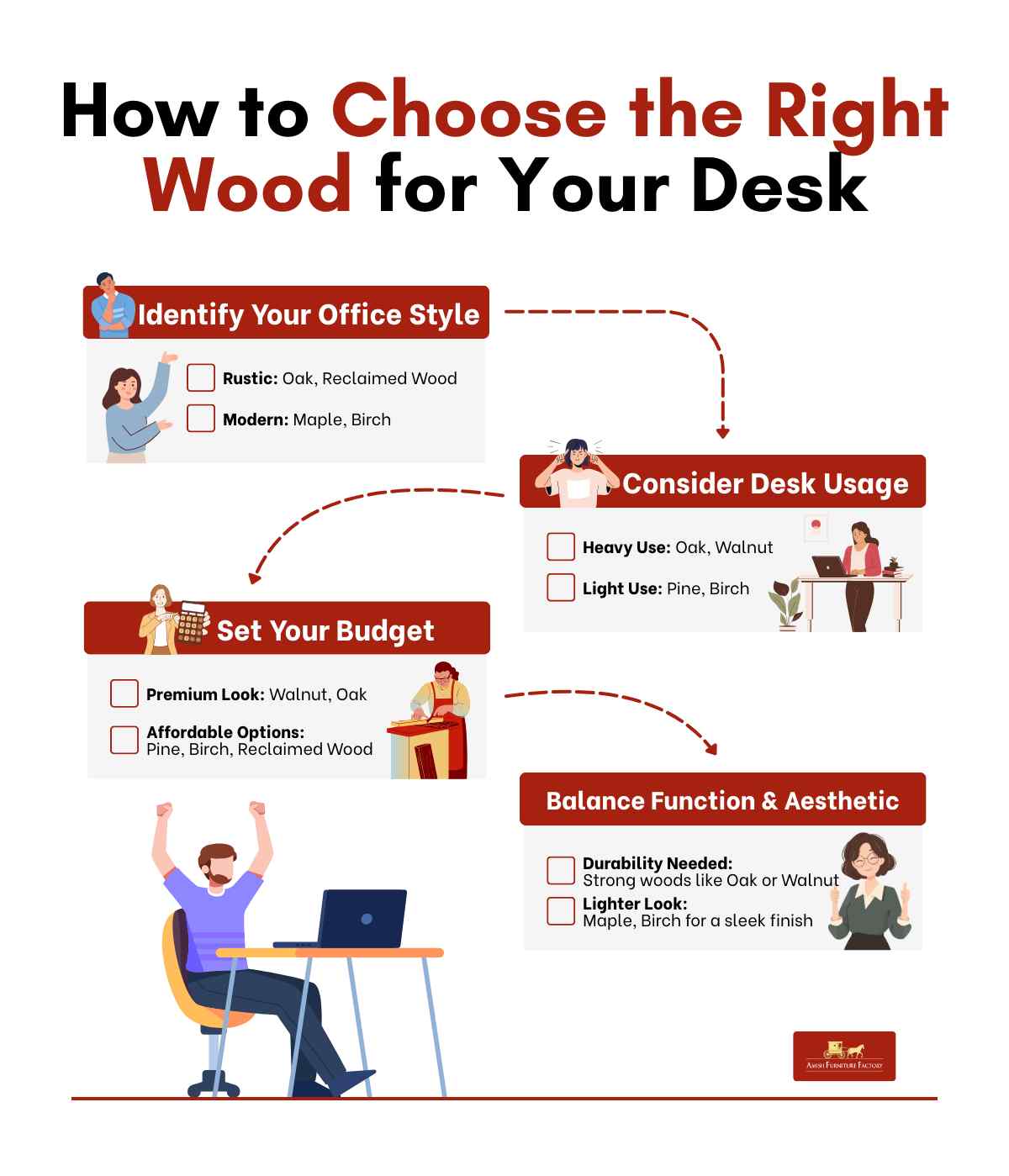
Conclusion
Choosing the right and best wood for building a desk can make all the difference in creating a space that reflects your personal style. Whether you prefer the warmth and charm of rustic wood or the sleek, polished look of modern materials, there’s a wood out there that’s perfect for your workspace. By understanding the key features of different woods and how they fit into various desk styles, you can ensure that your new desk will be as functional as it is beautiful. So, take your time, think about your office’s aesthetic, and get started on creating the desk of your dreams.
Frequently Asked Questions
What is the best wood for building a desk if I’m on a budget?
Pine is a budget-friendly option that can achieve both rustic and sleek looks depending on the finish. Birch is another affordable choice, offering a clean, minimalist aesthetic at a reasonable price.
How do I care for and maintain my wooden desk?
Regularly dust your desk with a soft cloth and avoid harsh chemicals. Apply protective wax or oil to woods like oak and walnut every few months to preserve their finish.
Can I combine different types of best wood for building a desk?
Yes, mixing different best wood for building a desk can create a unique and personalized design. For example, pairing a walnut desk top with maple or birch legs can add texture and visual interest.